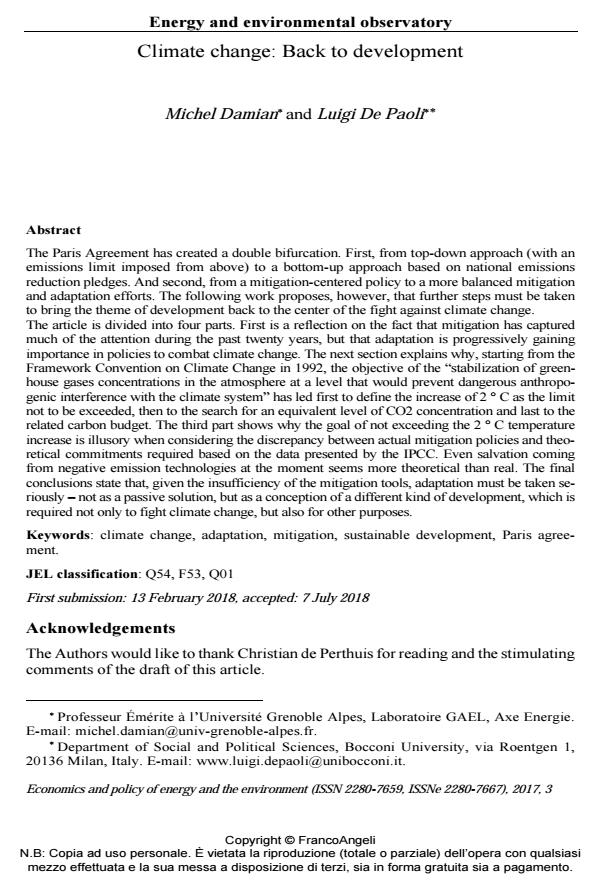Climate change: Back to development
Titolo Rivista ECONOMICS AND POLICY OF ENERGY AND THE ENVIRONMENT
Autori/Curatori Michel Damian, Luigi De Paoli
Anno di pubblicazione 2018 Fascicolo 2017/3
Lingua Inglese Numero pagine 20 P. 5-24 Dimensione file 277 KB
DOI 10.3280/EFE2017-003001
Il DOI è il codice a barre della proprietà intellettuale: per saperne di più
clicca qui
Qui sotto puoi vedere in anteprima la prima pagina di questo articolo.
Se questo articolo ti interessa, lo puoi acquistare (e scaricare in formato pdf) seguendo le facili indicazioni per acquistare il download credit. Acquista Download Credits per scaricare questo Articolo in formato PDF

FrancoAngeli è membro della Publishers International Linking Association, Inc (PILA)associazione indipendente e non profit per facilitare (attraverso i servizi tecnologici implementati da CrossRef.org) l’accesso degli studiosi ai contenuti digitali nelle pubblicazioni professionali e scientifiche
The Paris Agreement has created a double bifurcation. First, from top-down approach (with an emissions limit imposed from above) to a bottom-up approach based on national emissions reduction pledges. And second, from a mitigation-centered policy to a more balanced mitigation and adaptation efforts. The following work proposes, however, that further steps must be taken to bring the theme of development back to the center of the fight against climate change. The article is divided into four parts. First is a reflection on the fact that mitigation has captured much of the attention during the past twenty years, but that adaptation is progressively gaining importance in policies to combat climate change. The next section explains why, starting from the Framework Convention on Climate Change in 1992, the objective of the "stabilization of greenhouse gases concentrations in the atmosphere at a level that would prevent dangerous anthropogenic interference with the climate system" has led first to define the increase of 2 ° C as the limit not to be exceeded, then to the search for an equivalent level of CO2 concentration and last to the related carbon budget. The third part shows why the goal of not exceeding the 2 ° C temperature increase is illusory when considering the discrepancy between actual mitigation policies and theoretical commitments required based on the data presented by the IPCC. Even salvation coming from negative emission technologies at the moment seems more theoretical than real. The final conclusions state that, given the insufficiency of the mitigation tools, adaptation must be taken seriously - not as a passive solution, but as a conception of a different kind of development, which is required not only to fight climate change, but also for other purposes. .
Parole chiave:Climate change, adaptation, mitigation, sustainable development, Paris agreement
Jel codes:Q54, F53, Q01
- Global impacts of projected climate changes on the extent and aboveground biomass of mangrove forests Lidiane P. Gouvêa, Ester A. Serrão, Kyle Cavanaugh, Carlos F. D. Gurgel, Paulo A. Horta, Jorge Assis, in Diversity and Distributions /2022 pp.2349
DOI: 10.1111/ddi.13631 - СТАЛИЙ РОЗВИТОК ЯК СОЦІАЛЬНО-ЕКОНОМІЧНА МОДЕЛЬ «ВИГРАШ-ВИГРАШ»: КОНТЕКСТИ ОКРЕМИХ КРАЇН ТА РЕКОМЕНДАЦІЇ ДЛЯ УКРАЇНИ Максим Філяк, Володимир Аредов, in Mechanism of an economic regulation /2024 pp.61
DOI: 10.32782/mer.2024.104.08
Michel Damian, Luigi De Paoli, Climate change: Back to development in "ECONOMICS AND POLICY OF ENERGY AND THE ENVIRONMENT" 3/2017, pp 5-24, DOI: 10.3280/EFE2017-003001